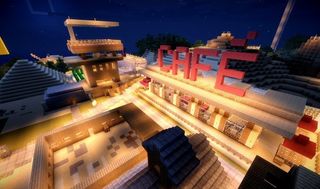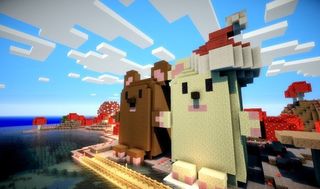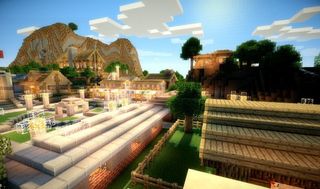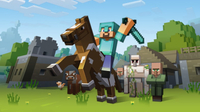The Future of Minecraft: what lies ahead for the all-conquering sandbox game?

This article originally appeared in issue 246 of PC Gamer UK. Read our feature on the making of Minecraft here.
It's hard to imagine how Minecraft could become any bigger than it already is, or how Mojang could spend the money if it did. Then the Mojang guys tell me. It sounds like a good plan.
Instead of indefinitely expanding Minecraft's in-game content, Mojang intend to gift its future to the modders and tinkerers.
“I think we're getting to a point where everything new I'm thinking of should probably be a mod,” says Minecraft's helmsman Jens 'Jeb' Bergensten. “The features are getting more and more specific and not so useful to everyone. Adding new animals and monsters hasn't felt like it's extended the game – and maybe I should work on something more useful, even though I know animals or mobs are the most appreciated content. In the recent snapshot we added bats. They don't really do anything, they just fly around and sit in roofs and sleep. But people are very happy about it.”

The modding community for Minecraft is already colossal and responsible for a huge volume of quality output. There are mods which add Pokémon, mods which add Portal guns, mods which add steampunk dirigibles. Custom maps, meanwhile, can completely upturn Minecraft's ruleset, like the perilous, puzzley resource scramble of Sky Blocks, or the vicious PvP of The Hunger Games mod.
But the lack of official modding tools has meant the community's offerings have been disparate, inconsistent, difficult for Minecraft's less techy players to use and occasionally dangerous. The solution is to build an official mod API, enabling Mojang to endorse well-tested mods and offer them through a central repository in-game.
“Hopefully they will be easier to install and less prone to destroy your game,” says Markus 'Notch' Persson, Minecraft's original creator.
PC Gamer Newsletter
Sign up to get the best content of the week, and great gaming deals, as picked by the editors.
This is no small task, however. Radical changes cannot be made to the game's API after launch, so getting it (mostly) right first time is important. And getting it right means changing a lot of Minecraft's basic infrastructure.
“We're rewriting the rendering – basically rewriting the client side of Minecraft from scratch,” says Nathan 'Dinnerbone' Adams, who was hired from the community for his work on Bukkit, the most popular of Minecraft's unofficial modding toolsets. “I think it'll be a couple of months before we see the initial versions of the API.”

Jeb also talks of making it easier to add and animate models, and fundamentally changing the way the game stores data regarding its many materials and items. But though modders will dominate Minecraft's future, for the short term at least, Mojang will continue to release weekly 'snapshots', optional downloads of unfinalised content, which continue to extend the game in unusual ways – or, more accurately, enable the players to do so.
“In the recent snapshot we've added something called the command block,” Jeb says. “When it's triggered, you can teleport players to a certain position, or change the game mode. So this user called Sethbling has created a Team Fortress 2 map for Minecraft. You can choose a class, it has control points, and everything works like TF2. It's quite amazing.”
But what's critical about this process is putting the community's most outlandish, most brilliant creations in the hands of all users – even those who are largely computer-naïve. The mod browser is one part of this, but Mojang are going further with a plan to offer private servers to players in-game.
“We want to make it easier for families and people with little knowledge of computers to create persistent servers,” says Jeb. “So we'll integrate our own server provider in the game. We mentioned this before and I got a lot of emails from server provider companies scared that we would force them out of business. I can understand it might look that way, but our target audience is not the same. Our hosting service will probably be too simple for the hardcore who buy servers now; we'll aim for servers with eight-to-ten people max.”

Patrick Geuder, Mojang's data analyst, has been working hard to identify trends in how people play Minecraft – and, more importantly, when they quit. Tutorials designed to smooth out those bumps may well be in the offing. Meanwhile, platform-specific versions of Minecraft will evolve into bespoke experiences.
“For the iOS and Android version we're always looking for how we can use the camera and the GPS,” says Daniel Kaplan, who handles business development at Mojang. “We've been thinking about trying to pixelate your surroundings using Google Maps data – it'll be really cool to try to do it.”
And, serving as a fulcrum for all these developments, will be the revamped Minecraft website, helping to bring the most interesting community mods and custom maps to the surface.
Yet many of Minecraft's forthcoming developments won't involve a single line of code. In fact, despite being a game whose success was predicated on its availability as a digital download, you will soon see Minecraft for sale in the shops – not in a box, but as a voucher.

